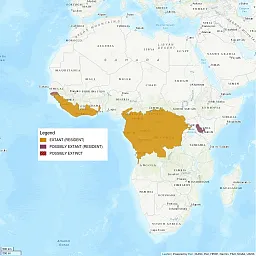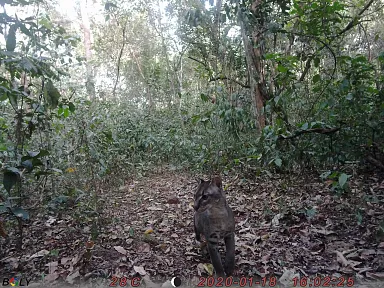African Golden Cat
Species Facts
Picture a large, muscular domestic cat – but double it in size. Give this animal a round face, a heavy muzzle, a short tail, and small, blunt untufted ears. Then visualize fur that varies from marmalade orange-red to sepia-gray, with each color phase unspotted, spotted all over, or somewhere in-between. The throat, chest, and undersides should be white or whitish, and the belly should be marked with bold dark spots or blotches.
Congratulations. You have just conjured up an African golden cat.
- Scientific Designation: Profelis aurata
- Endangered Status: Vulnerable (VU)
- Lifespan: Unknown
- Weight: 6.2-18 kg
- Length: 61-102 cm
- Shoulder Height: 40-50 cm
- Tail Length: 16-46 cm
Diet
This solitary cat preys on small mammals and birds. Its stocky build and short tail suggest that it is primarily a terrestrial hunter. Studies of activity patterns suggest that the golden cat is nocturnal.

Species Distribution
Found in the tropical forest region in Africa, the golden cat seems able to live in almost every type of forest (primary forest, secondary vegetation, recently logged forest with dense understory, and riverine forest). Even so, the golden cat is found most often in forested areas with very dense and moist secondary undergrowth, often along rivers.
Distribution map courtesy of IUCN (International Union for Conservation of Nature), compiled in 2015.

African Golden Cat. Photo © thierryachinkoproject on iNaturalist · some rights reserved
Threats to the Golden Cat
Although no reliable information is available on the African golden cat’s status in the wild, savannization and deforestation in West Africa probably has led to population declines and fragmentation (unless the cats find migration passages along river corridors). The bush meat trade, which figures largely in the region’s economy, is depleting populations of small antelope, an important prey of the golden cat. This may pressure the golden cat into making increased attacks on livestock.
There also appears to be some hunting by humans of golden cats. The African golden cat is currently classified as Vulnerable (VU) by the International Union for Conservation of Nature (IUCN) and protected under appendices II and III of the Convention on International Trade in Endangered Species (CITES).
Want to help us research and conserve this species?
Felidae Conservation Fund helps researchers around the world study and protect felids of all sizes.
Make sure you write a comment with "African Golden Cat" so we can designate 100% of your donation to go to protecting this species.
Do You Have 2-4 Hours A Month To Preserve Your Local Ecosystem?
Our volunteers are the driving force behind making true change in ecosystem health and wild cat conservation. Some like to volunteer in the field, others help us maintain our online presence, and some work with events. With just a few hours a month, you can make a difference, too.
Make A Difference Right Now
As a 501(c)3 nonprofit, our work is only possible because of generous donors like you.
More than 90% of your donation will go directly to our groundbreaking research, outreach, and education programs.
This is where true change starts. If you’d like to be a part of it, make a donation to Felidae Conservation Fund today:
Or,

